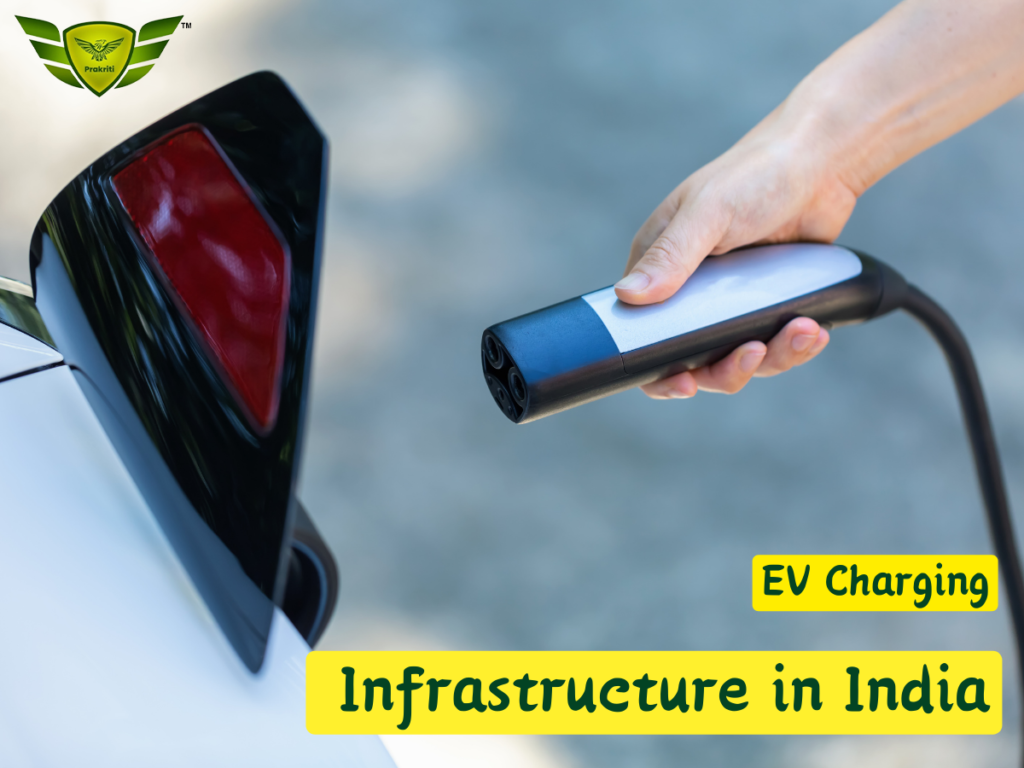EV Charging infrastructure in India

Home About Us Product Prakriti Defender Prakriti Neo Prakriti ESPA Prakriti Super Royal Test Ride Blogs Home About Us Product Prakriti Defender Prakriti Neo Prakriti ESPA Prakriti Super Royal Test Ride Blogs <a href=”https://forms.gle/hVFDmwD26WSCkJj99″> Dealership Enquiry </a> India’s <strong>EV charging infrastructure</strong> needs immediate attention. In order to encourage the further adoption of electric vehicles in India, a strong national charging network is essential. This is because, in addition to providing EV owners with fast and speedy vehicle charging, it will also—and maybe more importantly—allay drivers’ fears regarding their vehicles running out of gas. This is crucial since range anxiety remains the main obstacle to the widespread adoption of Venturous initiatives for EV charging infrastructure have been started by the Indian government. Most notably, incentives for EV adoption and the expansion of <strong>EV charging infrastructure</strong> are offered under the Faster Adoption and Manufacturing of (Hybrid &) Electric Vehicles (FAME) plan. By establishing the National Electric Mobility Mission Plan (NEMMP), which provides incentives for EV sales, the government has further accelerated the adoption of EVs. Nevertheless, private sector investment is necessary for these government measures to succeed in building charging infrastructure. It is not possible for the government to establish a strong and comprehensive charging network by itself. The construction of EV charging infrastructure should also involve private sector entities such as resident welfare associations (RWAs) and charging infrastructure providers. Finding India’s EV Infrastructure Obstacles: India has set a lofty goal by 2030, all forms of transportation would be electrified. India will require 46,000 EV charging infrastructure nationwide in order to reach this goal. The following illustrates India’s existing EV infrastructure situation, We examine three factors that are preventing India’s EV infrastructure from developing at the moment. Inadequate power grid: India’s increasing power consumption has already placed a great deal of strain on the power grid; it is projected to rise by 9–12% in the first half of 2023 alone. This can be made worse by adding EVs to the grid, which will lead to frequent power outages. This is particularly valid for rural regions. This lack of power has the potential to deter EV adoption by undermining the confidence of potential EV owners regarding the dependability of their vehicle’s charging. Decreased trust among consumers also deters private sector investment in EV charging infrastructure. Lack of public charging infrastructure: By 2030, nine cities will have 46,397 public charging stations constructed, according to the Bureau of Energy Efficiency (BEE). But as of the now, India only has 5, 234 charging stations dispersed throughout the country. Retail establishments, proprietors of small businesses, and RWAs can still be reluctant to offer public charging stations on their property even with government pressure. They are worried about how much capital these stations will need. They might not be aware of the advantages these stations could have for their companies. However, prospective EV owners continue to worry about the range of their cars in the interim. Geographical diversity: India is a large country with a varied geography. Different charging-related concerns are needed for its varied geography, which ranges from plains to mountains fed by rain. For instance, a portion of the infrastructure for EV charging must to be resilient to waterlogging, which happens frequently in some places four months out of the year. Furthermore, rural areas may need a whole different EV charging infrastructure than metropolitan areas due to differences in population density and travel patterns. Installing and maintaining charging stations in remote locations may be more difficult because to this enormous gap between rural and urban areas. To make matters worse, there might not be enough EVs in these rural locations to make the expenditure worthwhile. These problems call for creative answers, which could range from creating quick charging technologies to utilizing renewable energy sources. Solution to revolutionize Ev charging infrastructure in india: These problems call for creative answers, which could range from creating quick charging technologies to utilizing renewable energy sources. India is tackling the difficulties of building an effective and sustainable network of EV charging stations in a number of ways. The government is actively pushing the use of renewable energy to satisfy the rising demand for power, expanding the infrastructure for public charging, offering incentives for private sector investment, and creating fast charging and intelligent software solutions. The four most well-known efforts to transform EV charging in India are examined here: Increase public charging infrastructure: Along highways, in cities, and in public spaces, the Ministry of Power is building EV charging stations in India in partnership with organizations like the BEE. The Ministry of Heavy Industries has approved the building of 2,877 EV charging infrastructure throughout several states, in addition to 1,576 stations spread over 16 highways and 9 expressways, as part of the FAME India plan. Range concern will be greatly reduced if there are enough charging stations along India’s key routes, which span 10,275 kilometres’ addition, the Energy Efficiency Services Limited (EESL) project of the Ministry of Power has incentivized private entities to construct 810 electric vehicle charging stations. Additionally, the government is providing incentives for companies, retail establishments, parking lot managers, and RWAs to install EV charging stations on their property. The government is streamlining the installation procedures and increasing public awareness of the advantages of charging stations for companies. To meet its targets for EV charging infrastructure, India has to keep offering these incentives. The government is streamlining the installation procedures and increasing public awareness of the advantages of charging stations for companies. To meet its targets for EV charging infrastructure, India has to keep offering these incentives. Integrate renewable energy: Including renewable energy sources in the EV charging infrastructure can reduce costs and increase sustainability. It can lessen reliance on fossil fuels, which lowers pollution and the effects of global warming. It can also lessen the likelihood of power outages and lower the cost of EV charging for EV owners. India has a lot of potential for renewable energy because of its plentiful sunshine, flowing rivers, and favourable
